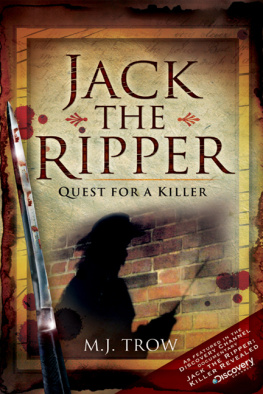
The Whitechapel Society gratefully acknowledges the following for the material and the assistance they have provided: The Bancroft Library; The Bishopsgate Institute; British Library Newspapers; The National Archives; www.casebook.org; www.jtrforums.com; Mark Galloway; Richard Nash; Robin Odell; Peter Leyland; Alyn Smith; Richard Clarke; Nicholas Connell; Ted Ball; Roger Palmer and Stewart P. Evans.
A special thank you to our members for their continued support.
The opinions expressed in this publication are those of the individual authors and do not represent the Whitechapel Society as a whole.
Contents
By Frogg Moody |
|
By Clare Smith |
| The Victims of Accusations |
By Yasha Beresiner |
|
By Sue Parry |
|
By Mickey Mayhew |
|
By Andrew ODay |
|
By Alfred Beadle |
|
By Adrian Morris |
|
By Jacqueline Murphy |
|
By George Fleming |
|
By Ted Ball |
By Robin Odell
The eighteenth-century English poet Thomas Gray wrote the following lines in another age which might have served as an ode to the victims of The Whitechapel murders.
Alas, regardless of their doom
The little victims play
No sense have they of ills to come
Nor care beyond today
In Memoriam
Mary Ann Nichols 18451888
Annie Chapman 18411888
Elizabeth Stride 18431888
Catherine Eddowes 18421888
Mary Jane Kelly 18631888
The question What about the victims? has frequently been voiced in the wake of Britains most notorious murders and especially in the aftermath of the Moors Murders which shocked the public in 1966. In the following decades, while regular attention was devoted to Myra Hindley and Ian Brady, there was little focus on their victims. Who remembers the names of the Brides in the Bath or the identities of the women gassed by John Christie?
Perhaps it is the fate of murder victims to be quickly forgotten while their perpetrators achieve notoriety and fame. The names of the fallen in modern wars are rightly recorded and remembered but there are few memorials to murder victims. And, it should not be forgotten that victimhood, if there is such a condition, is also conferred on the families of those murdered. As the American social scientist J. L. Barkas put it in 1978, We are all victims.
And, the net which ensnares victims extends even further when wrongful accusations of criminality are made or suspects are rounded up for questioning. In a sense, they too are victimised. In the case of the Ripper murders, George Hutchinson, Joseph Barnett, Jacob Isenschmid and John Pizer were four such contemporary suspects. The mantle of being under suspicion carried its own opprobrium.
In the 125 years since Jack the Rippers murders rocked Whitechapel and Spitalfields, scores of identities have been proposed for the otherwise anonymous murderer. Only one can possibly be correct, which means that the rest have been falsely accused and thus become unwittingly victimised in the process.
Notions of victimhood or becoming a murderee have long been debated, although victimology has a more recent history. The celebrated true crime writer F. Tennyson Jesse first coined the word murderee in the 1920s to describe what she called a race of human beings who lay themselves out to be murdered , that is, individuals who are disposed to become victims.
In her book Murder and its Motives , Tennyson Jesse wrote that the word murderee seemed to fill a long-held want, noting that The Times had adopted it. But she later wrote of wishing that she had not coined the word. At any rate, it had a short life, as victim became the accepted norm.
Concepts of victimology surfaced in the late 1930s with the suggestion that the personality of the victim was a crucial factor in attracting the criminal perpetrator. And, in 1948, Hans von Hentig, a German criminologist, wrote that if there was such an individual as a born criminal, there must also be a born victim. In his study, The Criminal and his Victim , he made reference to individuals who knowingly placed themselves in dangerous situations, thereby inviting sought-after excitement and, possibly, ill-treatment.
Some of this thinking was taken up in America in the mid-1950s by Marvin E. Wolfgang, Professor of Criminology at the University of Philadelphia. He conducted an analysis of over 500 murders and made a particular study of the relationship between murderers and their victims. Wolfgang set this out in his seminal work, Patterns in Criminal Homicide , in which he developed the concept of victim-precipitated homicide. In the dynamics between perpetrator and victim, there might be a moment when the victim initiates physical violence.
Wolfgang found from his study of Philadelphia murders that in only 14 per cent of cases were the killer and victim unknown to each other. This situation would change significantly with the advent of the serial killer, and over the next twenty years, the percentage of stranger killings in the USA rose to 30 per cent.
The interplay between murderer and victim in the Ripper killings can only be a matter of conjecture, but it was clearly a potent factor to the extent that the perpetrator was never caught. It is commonly accepted that the Rippers modus operandi was that of a serial killer. Patricia Cornwell, in her book Portrait of a Killer , noted that victims of serial murder often share some trait that is significant to the killer. That common factor must surely be that they were prostitutes and, because of their calling, were both available and vulnerable. Joel Norris, in his book Serial Killers , gives a pen picture of this type of murderer whom he describes as having two effective weapons mobility and normality. He is an individual who sees himself as a solitary stalker with a finely-tuned sense of survival.
It is tempting to think of Jack the Ripper as a lone marauder with a murderous agenda, circling the flock to target and detach a lamb for the slaughter. He knew that the East End prostitutes were easy prey for a motivated killer. But, was he really a stranger, someone from outside the area, drawn there by the availability of potential victims? Or was he an insider, a man who lived and worked in the district, totally familiar with the people and their way of life?
While a total stranger might convey a certain allure or mystery for the women he approached, he would lack the familiarity of the insider. The circumstances in which the murders were committed suggest that the perpetrator was readily accepted for his ordinariness by the women he approached, who perhaps saw him as one of their own community. Thus disarmed, they became perfect victims. This assessment seems to accord in principle with that reached by the FBIs criminal profilers in 1988.
Of the many identities and names put forward as Ripper suspects, only one can be correct, which means that the rest have become victims of circumstance and unsubstantiated allegations. This process was aided and abetted by Sir Melville Macnaghtens famous memorandum, in which he named his three suspects with the comment that he was inclined to exonerate the last two, thereby relegating them to the ranks of victims by association. Thus, the Macnaghten Three take their place alongside The Guildford Four and The Birmingham Six.
Next page












